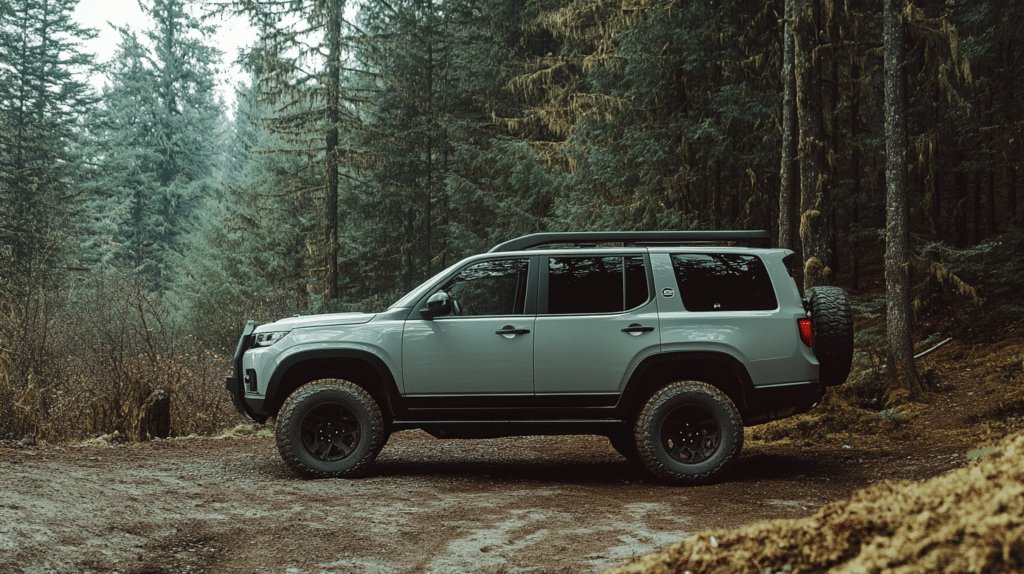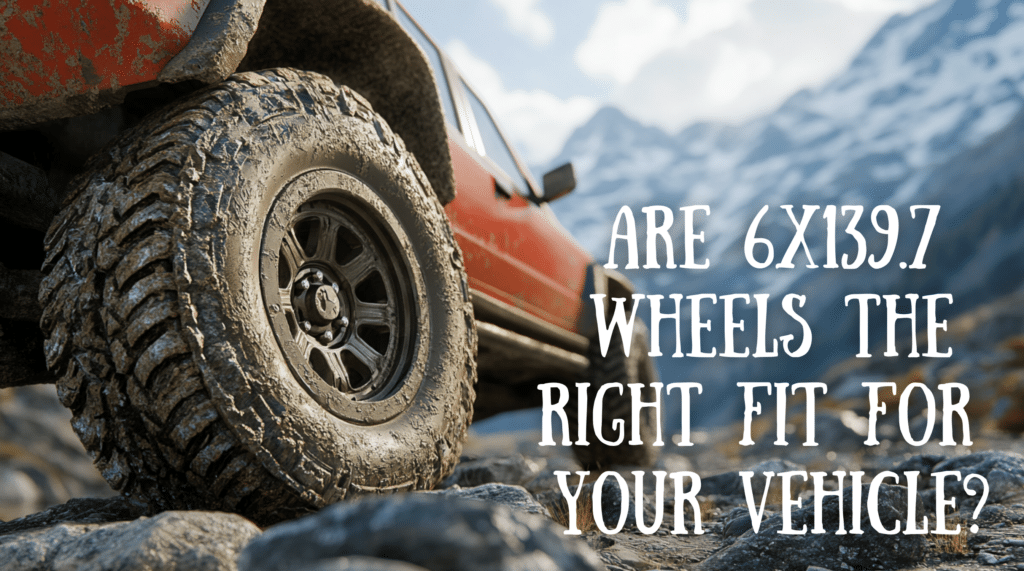Want to know a surprising fact? Most people buy the wrong wheels because they can’t decode the numbers on them.
I know the feeling – staring at “6×139.7” and wondering what it means.
I’ve seen many vehicle owners spend hundreds of dollars on wheels that don’t fit their cars.
Some even damaged their vehicles, trying to force-fit incompatible wheels.
But here’s the good news: I’ve spent years working with different wheel patterns, and I’m here to share what I’ve learned.
In this guide, I’ll explain the 6×139.7 wheel pattern. You’ll learn exactly what these numbers mean and whether they’re right for your vehicle.
Understanding 6×139.7 Wheels & Its Measurements
Regarding wheels, the term “6×139.7” describes a specific bolt pattern.
This measurement is essential to ensure the wheels fit securely on a vehicle.
Here’s what it means and why it matters:
What Does 6×139.7 Mean?
The “6” refers to the number of bolt holes on the wheel. These holes are arranged in a circular pattern.
The “139.7” represents the diameter (in millimeters) of the circle that passes through the center of these bolt holes.
Together, these measurements define the wheel’s bolt pattern and ensure a proper fit for vehicles designed to accommodate this specification.
Key Measurements And Specifications
To fully understand 6×139.7 wheels, it’s important to consider additional key measurements:
- Hub Bore: The diameter of the wheel’s center hole. It ensures the wheel sits flush on the vehicle’s hub.
- Offset: This indicates how far the mounting surface of the wheel is from the centerline. A positive offset means the mounting surface is closer to the front, while a negative offset places it closer to the back.
- Diameter and Width: These define the overall size of the wheel and affect the choice of compatible tires.
Why These Measurements Are Important
- Proper Fitment: Ensures the wheel mounts securely to the vehicle without misalignment.
- Safety: Incorrect measurements can lead to unstable driving or damage to wheel components.
- Performance: Accurate sizing enhances handling, load capacity, and overall vehicle performance.
Understanding the 6×139.7 measurements will better equip you to select wheels that fit your vehicle perfectly, ensuring both functionality and aesthetics.
Factors To Consider When Selecting Wheels With A 6×139.7 Bolt Pattern
Choosing the right wheels with a 6×139.7 bolt pattern requires careful consideration of several factors.
These ensure compatibility, safety, and optimal performance for your vehicle. Here’s what you need to keep in mind:
1. Vehicle Compatibility
Confirm that your vehicle supports the 6×139.7 bolt pattern. Check your owner’s manual or consult a professional to verify fitment.
Ensure the wheel’s hub bore matches your vehicle’s hub size to avoid vibrations.
2. Load Capacity
The wheel must support the weight of your vehicle, including any extra load from passengers or cargo.
Look for wheels with a load rating that matches or exceeds your vehicle’s gross weight requirements.
3. Material And Durability
Steel Wheels: Durable and budget-friendly, ideal for heavy-duty vehicles and off-road use.
Alloy Wheels: Lightweight, with better heat dissipation and aesthetic appeal, but may cost more.
Choose the material based on your driving conditions and aesthetic preferences.
4. Offset And Backspacing
Offset affects how the wheel aligns with the vehicle’s fender and suspension components.
Incorrect offset can lead to clearance issues or impact handling.
Backspacing ensures there’s enough room between the wheel and the suspension.
5. Tire Compatibility
Make sure the wheel size matches the tire specifications. Oversized or undersized tires can affect performance and safety.
Consider the width and diameter of the wheel for proper tire fitment.
6. Purpose And Driving Conditions
For off-road vehicles, prioritize wheels designed to handle rugged terrain.
Consider wheels that balance durability, comfort, and aesthetics for daily driving.
7. Aesthetic Preferences
Wheels come in various finishes like matte black, chrome, and polished aluminum. Choose one that complements your vehicle’s style.
8. Budget
High-quality wheels often come with a higher price tag, but they ensure durability and performance.
Balance cost with quality to find wheels that meet your needs without compromising safety.
Considering these factors, you can select 6×139.7 wheels that not only fit your vehicle but also enhance its performance and appearance. A well-chosen wheel significantly improves your driving experience.
How To Know If 6×139.7 Wheels Are The Right Fit For Your Vehicle
Let me help you determine if these wheels will work for your vehicle.
First, check your owner’s manual for your vehicle’s bolt pattern. Any qualified mechanic can measure it for you if you can’t find it there.
The wheel’s center hole must be the same size as your vehicle’s hub. Even a small mismatch can cause your ride to shake and become unsafe.
To make the wheel fit properly, you might need hub rings.
The wheels also need to fit right on your vehicle. This means checking the offset—how far in or out the wheels sit from your fender. A wrong offset can cause rubbing or poor handling.
Think about how you use your vehicle. These wheels work well on many SUVs and trucks, whether you drive in the city or off-road. They’re also good for towing and carrying heavy loads.
If you’re not sure, talk to a wheel expert. They can tell you if 6×139.7 wheels will fit and work well with your vehicle.
How To Install Wheels With A 6×139.7 Bolt Pattern
Installing wheels with a 6×139.7 bolt pattern requires precision and the right tools to ensure safety and optimal performance.
Follow these step-by-step instructions for a seamless installation:
Tools Required
- Jack and Jack stands
- A lug wrench or torque wrench
- Socket set
- Anti-seize lubricant (optional)
Step-by-Step Installation
1. Prepare The Vehicle
Ensure your vehicle is parked on a level surface with the parking brake engaged.
Use a lug wrench to loosen the lug nuts on the existing wheels slightly, but do not remove them completely.
2. Lift The Vehicle
Use a jack to lift the vehicle until the wheels are off the ground.
Place the jack securely under the vehicle for safety before removing it.
3. Remove Old Wheels
Completely unscrew the loosened lug nuts and set them aside.
Carefully remove the old wheels from the hub.
4. Clean The Hub
Inspect the hub for any debris, rust, or damage.
Clean the hub surface to ensure the new wheel sits flush.
Apply anti-seize lubricant if desired to prevent future corrosion.
5. Install New Wheels
Align the bolt holes of the new wheel with the hub’s bolt pattern.
Push the wheel onto the hub until it sits flush.
6. Lower And Torque
Use the jack to lift the vehicle slightly and remove the jack stands.
Slowly lower the vehicle back onto the ground.
Use a torque wrench to tighten the lug nuts to the manufacturer’s recommended torque specifications.
Always tighten them in a star pattern for even distribution.
Following these steps, you can confidently and safely install 6×139.7 wheels on your vehicle, ensuring a proper fit and optimal performance. If you’re unsure at any stage, consult a professional for assistance.
Common Mistakes To Avoid During Installation
Proper wheel installation is crucial for safety and performance. Avoid these common mistakes when installing 6×139.7 wheels:
- Incorrect Torque: Always use a torque wrench to tighten lug nuts to manufacturer specifications.
- Skipping the Star Pattern: Tighten lug nuts in a star pattern to ensure even pressure.
- Dirty Hub: Clean the hub to avoid vibrations caused by debris or rust.
- Wrong Hub Bore Size: Ensure the wheel matches the hub diameter or use hub-centric rings.
- Loose Lug Nuts: Recheck tightness after 50-100 km of driving.
- Improper Tools: Use the right tools to avoid stripping threads or damaging lug nuts.
- Skipping the Test Drive: Test drive to detect any vibrations or noises.
Applications Of The 6×139.7 Wheels In Different Vehicles
The 6×139.7 bolt pattern is widely used across various vehicle types due to its strength, versatility, and reliability. Here’s how it applies to different vehicles:
1. SUVs
- Commonly used in mid to full-size SUVs for their ability to handle heavy loads and rugged terrains.
- Popular models include the Toyota Land Cruiser and Chevrolet Tahoe.
2. Trucks
- It is ideal for light and heavy-duty trucks, providing durability for towing and hauling.
- Found on models like the Ford F-150 and GMC Sierra.
3. Off-Road Vehicles
- Perfect for off-road enthusiasts due to their robust design and compatibility with larger tires.
- Common in vehicles like the Jeep Gladiator and Toyota 4Runner.
4. Commercial Vehicles
- Used in work vehicles, including vans and utility trucks, for their ability to support significant weight.
- Examples include delivery trucks and service vans.
5. Adventure Vehicles
- Frequently chosen for campers and overlanding setups requiring reliable performance in challenging conditions.
- Suited for vehicles like the Nissan Patrol and Mitsubishi Pajero.
The versatility of 6×139.7 wheels makes them a top choice for vehicles that require strength, durability, and adaptability across various applications.
Benefits Of The 6×139.7 Wheels

Let me tell you what makes these wheels stand out from others.
These wheels work well on many vehicles, from everyday trucks to large SUVs. They fit many makes and models.
You can drive them in the city or on rough roads without problems.
These wheels last a long time and stay strong. They work great for pulling trailers and carrying heavy loads.
Many work trucks use them because they keep going even after years of hard use.
Your vehicle stays steadier with these wheels, especially in bad weather or on rough roads.
The six-bolt design helps spread weight better, which means better tire grip.
You also have choices in how they look. These wheels come in many styles, so you can make your truck or SUV look good while still getting the strength you need.
List Of Vehicles Using 6×139.7 Wheels
| Category | Vehicle Models |
|---|---|
| SUVs | Toyota Land Cruiser, Toyota 4Runner, Chevrolet Tahoe, GMC Yukon, Nissan Armada |
| Trucks | Ford F-150 (Certain models), GMC Sierra 1500, Chevrolet Silverado 1500, Toyota Tundra, Nissan Titan |
| Off-Road Vehicles | Jeep Gladiator, Mitsubishi Pajero, Toyota Hilux, Isuzu D-Max, Ford Ranger |
| Commercial/Utility | Toyota Hiace (Certain models), Nissan NV350, Mitsubishi L200 |
This table categorizes vehicles commonly using the 6×139.7 bolt pattern, making it easier to identify compatible models. Always confirm your vehicle’s specifications before purchasing wheels.
Conclusion
Choosing wheels for your vehicle isn’t just about looks but safety and performance.
The 6×139.7 wheel pattern works with many trucks and SUVs, making it a common choice for vehicle owners.
Understanding wheel measurements helps you make smarter choices.
Knowing what those numbers mean and how to check if they’ll fit your vehicle saves time and money. You also keep your vehicle running safely.
Remember, proper installation matters as much as choosing the right wheels. Taking the time to measure, check compatibility, and follow the right steps pays off in the long run.
Your vehicle’s performance, safety, and peace of mind depend on getting these basics right.


